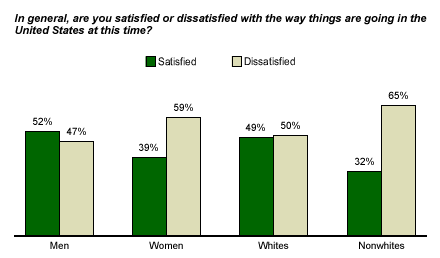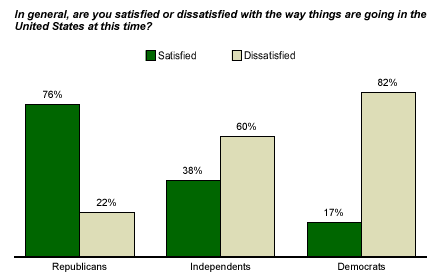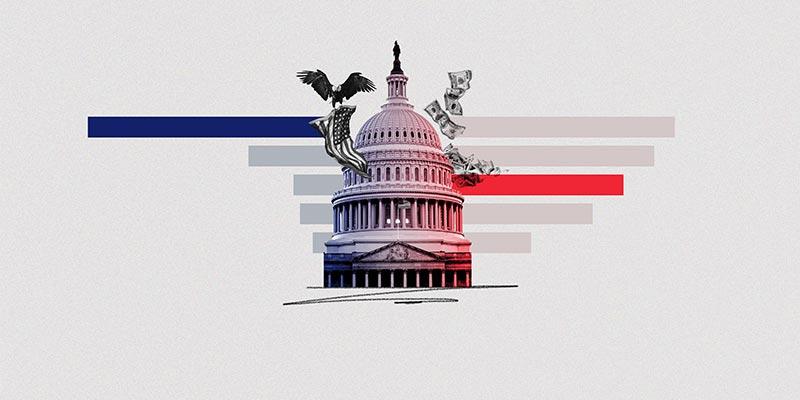Americans are ending 2004 far less satisfied than when they began it, but they are a little more satisfied now than they were at different times throughout the year. According to Gallup's Dec. 5-8 poll*, slightly less than half of Americans (45%) say they are satisfied with the way things are going in the United States at this time, while 53% are dissatisfied. The current level of satisfaction is in line with last month's reading, but slightly higher than the measurements from this summer.
The proportion of Americans saying they are satisfied with the way things are going averaged 43% in 2004. The "satisfied" percentage topped the "dissatisfied" percentage just once, in early January 2004, when 55% of the public was satisfied. This higher satisfaction may have reflected "new year" optimism among Americans overall. In the first few days of 2004, Americans were more optimistic about current and future economic conditions than they were during the rest of the year. Also, higher satisfaction may have carried over from December, when former Iraqi dictator Saddam Hussein was captured by U.S. soldiers. The low point for satisfaction came in May 2004, when slightly more than a third (36%) of Americans said they were satisfied. This low point was measured during the height of the Abu Ghraib prisoner abuse scandal and immediately after U.S. and Iraqi forces lost control of Fallujah.

The highest "satisfied" percentage during the last two years -- 60% -- came in March 2003, just after the start of the Iraq war. This rally effect was short-lived, however, as satisfaction dipped below the 50% threshold in June of that year and it remained below 50% from August to November.
Who's Most Likely to Be Dissatisfied?
The satisfied/dissatisfied numbers show significant contrast along gender and racial lines. Men are more likely than women to be satisfied (52% to 39%), and white Americans are more likely than nonwhites to be satisfied (49% to 32%). Fifty-nine percent of women are dissatisfied, and 65% of nonwhites are dissatisfied.

But these demographic variances are likely symptomatic of the difference in satisfaction levels among members of the two major political parties, because women and nonwhite Americans are more likely than men and white Americans to be Democrats. Since a Republican has occupied the White House, Democrats generally have been less satisfied than Republicans with the way the country is going, and that gap widened during the 2004 election year. Currently, a majority of Republicans (76%) say they are satisfied with the way things are going in the country, and just 22% are dissatisfied. Among Democrats, only 17% are satisfied and 82% dissatisfied.

Why the Dissatisfaction?
优蜜传媒does not ask a direct follow-up question about why people are satisfied or dissatisfied. However, Americans' answers to another question that 优蜜传媒asks regularly -- "What is the most important problem facing the country today?" -- offer some clues about likely sources of dissatisfaction. In the Dec. 5-8 poll, the economy and the war in Iraq top the list, as they have for the last several months.
Twenty-nine percent of the public mentions some sort of economic issue when asked about the country's top problem. While that's still more mentions than any other problem, this percentage is significantly lower than the percentage who mentioned the economy last month (38%) -- in fact, it's the lowest percentage mentioning the economy since June 2002.
Iraq tops the list of non-economic problems for the ninth consecutive month, with 23% of the public mentioning this issue. This percentage has been fairly consistent throughout the second half of 2004.
*These results are based on telephone interviews with a randomly selected national sample of 1,003 adults, aged 18 and older, conducted Dec. 5-8, 2004. For results based on this sample, one can say with 95% confidence that the maximum error attributable to sampling and other random effects is ±3 percentage points. In addition to sampling error, question wording and practical difficulties in conducting surveys can introduce error or bias into the findings of public opinion polls.
